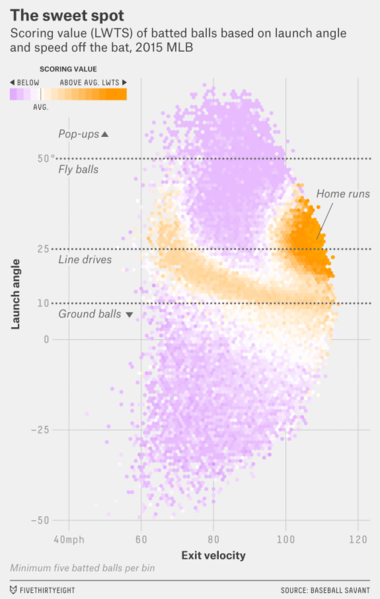http://fivethirtyeight.com/fea...-science-of-hitting/
I encourage all to study this in depth. This is indisputable evidence that launch angles need to be above 10 degrees. In fact that 10 degree mark we keep talking about doesn't become productive at all til at least 90mph exit velocity. With today's technology there is no longer room for difference of opinion. There really is a right and wrong. We need young people like dom to get involved with coaching and push the lazy old coaches out who don't want to study the game and learn these things. Hitting the back of the cage = bad A lot of the time. At best it is an incomplete picture. Hitting the very upper left corner in the back of the cage at 105mph exit velocity = really good! Hitting the back of the cage 4 feet off the ground = ground ball. If you really are serious about setting a launch angle goal 10 degrees is not the answer. You want that to be your 'mistake' on the low end that might just squeak through the infield. Anything below 10 as you can see is almost purely bad unless there is tremendous exit velocity. Interestingly enough notice there is a lot more production from Texas leaguers with low exit velocity and high launch angle than from under 10 degrees. That would be a dangerous and unproductive line to hang your hat on.
Well, 2020, I'm sure this will come as no surprise to you but I don't completely agree.... call me a lazy old coach I guess. I believe there is definitely room for difference of opinion and that is fully taking into consideration today's technology and data.
The data is from MLB. My line of questioning has been how that may relate to the average HS player. I think it is important to use ALL the data and also take into account all the different factors that come into play when comparing the MLB game to the HS game. Here is an excerpt from the article that you encourage everyone to study in depth...
"...the success of a ball struck at a more intermediate angle is extremely sensitive to its exit velocity. For instance, at a launch angle of about 25 degrees, run values can vary sharply depending on how fast the ball leaves the bat. Low exit velocities tend to result in short-hoppers to the infielders, which are easy outs. But as batters hit the ball slightly harder, those liners get progressively stronger, eventually sailing over infielders’ heads for bloop singles. Then the run value drops again, as those line drives begin to travel within reach of the outfielders."
Translation - a hitter with exit velo that is not above average (most average HS hitters) will not garner the same positive results from that 25 degree launch angle like a MLB power hitter will.
I'll combine that point with some other facts. HS infielders are not nearly as consistent with fielding and throwing, nor are they nearly as agile and athletic as MLB infielders. Also, HS infield surfaces are never as well groomed as MLB fields. I'm not saying that most HS infielders won't make the routine plays. But I am saying that hard ground balls (any GB's for that matter) are much more likely to result in hits or errors and tilt the scales as compared to the results you get from your MLB data. I am NOT proposing to teach hitting ground balls or hit down on the ball (more on this later).
Regarding exit velo, obviously, hitting the ball hard matters. Average HS hitters are not nearly as strong as MLB players. They also don't have the timing or swing mechanics that help maximize swing speed. Nor do they have the ability to consistently get the sweet spot of the barrel on the ball. So, we work with them to improve strength and mechanics. But we also try to teach them a swing path that is roughly on plane with the pitch. This maximizes their ability to barrel the ball more consistently and, thus, hit the ball hard with more frequency. It is effective and, guess what? The desired positive result for many players with that in mind is a hard line drive to the back of the cage! When the average HS player has an upward swing plane, the result is often inconsistent contact because the barrel is on plane with the ball for a shorter period of time. Now, by all means, if I have a more advanced player with power, we will work with that player with an elevated launch angle in mind.
Other excerpts from the article in your link even reference specific speedsters in the MLB who benefit from a much lower (even negative) launch angle.
I am NOT proposing to teach hitting ground balls. But I am pointing out that the scale shifts considerably when you consider the skill set of the average HS player and the nature of the average HS game. Often, it is most beneficial for the player and team that the "hard line drive" is the optimal objective.
We have plenty of players who move on to the next level with no issues succeeding with that approach as their base. One of the more recent power hitters went to a JC that tried to get him to shift from a fairly level swing to an uppercut. He struggled. He transferred to another school, went back to his original swing and became one of the top hitters and leading HR hitters in the league. Others have encountered successful college coaches who have asked them to maximize their speed and get the ball on the ground.
Even so, many HS players will never have a high exit velo. The idea of teaching them to work toward a higher launch angle for the future power that will never come doesn't ring true with me. If HS will be the end of the line, shouldn't we help them maximize their performance?
So, to summarize, I actually agree that the launch angle should be 10 degrees plus. I just don't buy the blanket statement that hitting the back of the cage is bad and that any coach teaching this should be put out to pasture.
BTW, I do also agree that Dominick will be a good addition to the coaching ranks.











